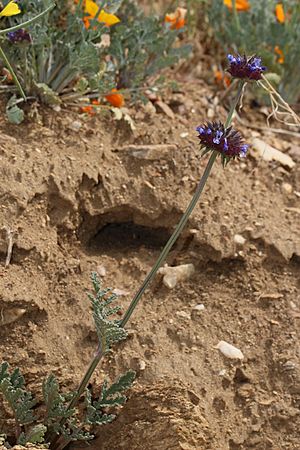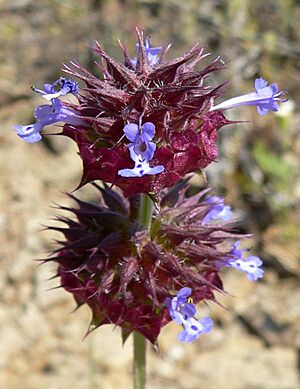Salvia columbariae facts for kids
Quick facts for kids Salvia columbariae |
|
|---|---|
 |
|
| Conservation status | |
| Scientific classification | |
| Genus: |
Salvia
|
| Species: |
columbariae
|
Salvia columbariae is a plant often called chia or desert chia. It is an annual plant, meaning it lives for only one growing season. Its seeds are used in a similar way to the chia seeds you might know from Salvia hispanica. This plant grows in dry areas across the southwestern United States, including California, Nevada, Utah, Arizona, and New Mexico. You can also find it in parts of Mexico like Sonora and Baja California. For many years, Salvia columbariae was a very important food source for Native American tribes. Some of their names for it include pashiiy (from the Tongva people) and it'epeš (from the Ventureño people).
Contents
What Does Chia Sage Look Like?
Salvia columbariae plants usually grow between 10 to 50 centimeters (about 4 to 20 inches) tall. Their stems have short, scattered hairs. The leaves at the bottom of the plant are oval-shaped and can be 2 to 10 centimeters (about 1 to 4 inches) long. These leaves are deeply cut into rounded sections.
The flowers grow on a tall stalk that rises from the ground. This stalk has special round leaves called bracts, which have a small bristle at the tip. There are usually one or two groups of flowers on each stalk. The cup-like part that holds the flower, called the calyx, is 8 to 10 millimeters long. The flowers themselves can be pale blue, blue, or purple at the tips. After the flowers, the plant produces small, tan to gray seeds called nutlets, which are about 1.5 to 2 millimeters long.
Where Does Chia Sage Grow?
Salvia columbariae likes to grow in dry, untouched places. You can often find it in areas with chaparral (dense shrubs) and coastal sage scrub. It usually grows at elevations lower than 2,500 meters (about 8,200 feet). If you were to grow it in a garden, it would prefer sunny, dry weather and soil that drains water well.
How People Use Chia Sage
For a long time, Salvia columbariae has been very useful to people, especially Native American tribes.
Traditional Medicinal Uses
Native American tribes used chia sage for different health purposes.
- The Cahuilla people used the seeds as a disinfectant. They would grind the seeds into a paste and put it on infections to help them heal.
- Several tribes, including the Cahuilla, Ohlone, Kawaiisu, and Mahuna, used the seeds to help clean their eyes. The seeds become jelly-like when wet. They would place these gelatinous seeds in their eyes to help remove sand or other small particles. They also used them for eye infections and inflammation.
- The Ohlone people also ate the seeds to help reduce fevers.
- The Diegueno people would chew the seeds when traveling long distances on foot. They believed it gave them strength and energy.
Chia Sage as Food
The seeds of Salvia columbariae were a very important food source for many tribes.
- The Cahuilla, Kawaiisu, Mohave, Tohono O'odham, Chumash, and Akimel O'odham tribes would grind the seeds. They mixed the ground seeds with water to make a thick, nutritious drink. The Cahuillas even found ways to remove bitter salts from the water to make the drink taste better.
- These tribes also dried the seeds to make cakes or a type of mush.
- The Ohlones, Mohave, and Pomo people made a special flour called pinole from the seeds.
- The Diegueno people sometimes added chia seeds to wheat to improve its flavor.
- The Mahuna, Paiute, and Akimel O'odham tribes made the seeds into a jelly-like material. They then cooked this into a porridge.
- Tribes like the Luiseno, Tubatulabal, and Yavapai used chia sage seeds as a major part of their diet.
Using Chia Sage for Building
The Mahuna people found another clever use for Salvia columbariae. They processed the plant into a fiber. This fiber was then used to cover their homes and shelters.
See also
 In Spanish: Salvia columbariae para niños
In Spanish: Salvia columbariae para niños



